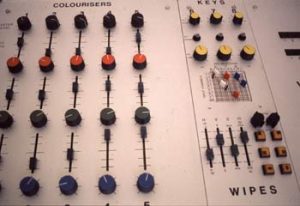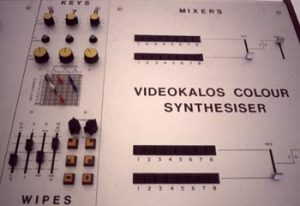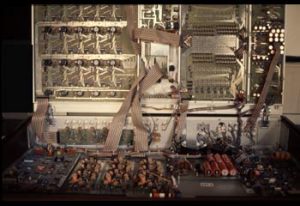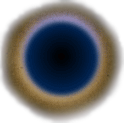One of the principal protagonists of the British early video scene, Peter Donebauer has forged a unique “intermedial” style that sets his work apart from both the better known American styles and the videographic methods of his British contemporaries. In fact, it is easier to place his earlier work within the lineage of visual music than that of the video art world, despite his appropriation of highly technical modes of articulation. “Intermedial” is a term, coined by the father of Fluxus, Dick Higgins, in the 1960s, used to describe the moment where different media not only combine and converse, but also fuse to create something entirely new; something in which the separate components can no longer be disentangled.
In most forms of early video experimentation, music and sound played a key role. Donebauer’s work, with its focus on the combination of music and image, but also on the live performance of the resulting audiovisuality, stands independent from any American or British video school, perhaps connecting more directly with the painted, animated and filmed visual music experimentation that occurred earlier in the century. Although his work does not seek a physically active audience in the same way that many of Nam June Paik’s video sculptures do, it does nonetheless demand a strong emotional engagement. Often abstract, his audiovisual works are not created according to the literary narrative time that informs most other moving-image media, but rather conjure forth a new and intermedial audiovisual temporal space that invites the audience-viewer to bring her own experiences into play in order to create meaning that is at once universal and deeply personal.
Like the American video pioneers, Donebauer drew his influences from other disciplines: from music, the improvisations of jazz and Indian classical ragas, and the soundscapes of Varèse, Xenakis and other composers involved in the electronic music scene; from painting, by the light and movement of Turner, the process-oriented work of Jackson Pollock and by the Zen school of painting in which works were created quickly after a protracted period of contemplation and preparation. There have been many attempts to combine arts and disciplines, but video—able to capture both sound and image simultaneously—provided users with a comparatively easy way in which to create palpable forms of intermediality. This promise of immediacy—of an audiovisual technology that could be played like an instrument—was particularly seductive to Donebauer. In early experiments with Cymatics in 1972, he had built a physical transducer able to produce a direct correlation between the audio and visual components of the video Portapak’s monochrome video signal. The artist then experimented with this in The Royal College of Art’s colour TV studio, using the engineering control area to process and colour images—and to sound them— electronically: in his own words, “The ‘emotional’ impact of colour in the image was suddenly as important an element as the ‘emotional’ impact of the music, and I was precipitated into ‘painterly’ concerns”. From this starting point, the artist developed many different ways in which to allow music and image to converse, with many of his methods reliant to some degree on gestures relating to the live and the collaborative. One of Donebauer’s earliest, yet most substantial, explorations of the audiovisual intermedial can be found in his 1973-78 group of seven pieces, “The Creation Cycle”, a collection of works created live within the Royal College’s TV Studio. With creative nods to Zen art and shamanistic practice, these works are based on the idea of process, rather than the traditional idea that art is an aesthetic object, itself static in time. Improvised within a pre-arranged structure to create a live, yet recorded form of audiovisuality, all seven sections, or pieces, explore this recalibration of the artistic process: in particular, their temporal, improvisatory quality engages with the creative sphere of music, rather than just with the static arts. This is particularly apparent in the second piece, “Entering”, his colourised eulogy on birth, broadcast in 1974 on BBC2’s art programme Second House: the first piece of “video art” commissioned and broadcast on UK national television. At eight minutes long, its three sections move kaleidoscopically around the concept—conceptual as well as physical—of birth, emerging from Eastern ideas about genesis and the birth of man. Although non-representational, the images clearly pertain to the oscillating tensions of order and chaos: creation and nature. This is an allegorical piece about rebirth in many senses, including Donebauer’s autobiographical journey towards becoming an artist. Here, the artist colourised his images created live in the TV studio to form a pioneering form of video visual language, in which his pulsating shapes draw the eye continually towards an ever-receding centre, symbolic of the constant flow and cycle of life. “Entering” was an audiovisual collaboration between Donebauer and his long-term musician collaborator Simon Desorgher, a flautist who studied electronic composition under Tristram Cary at the Royal College of Music.
Although recorded live, music and image were created according to the same aesthetic. Many video artists working in the USA, such as Paik, Steina Vasulka and Bill Viola began their lives as musicians, and therefore created single-authored audiovisual work. If music was sourced from elsewhere, as it most often was, it tended to be pre-existent, resulting in a visualisation of music, rather than an audiovisual dialogue. Here we have a genuinely collaborative process. Like the images, the sounds signify specifically, while at the same time occupying the realms of the nonrepresentational and abstract. Although a mixture of electronically-processed instruments and electronics, any trace of the original sound sources have been entirely effaced. The result is a disembodied sound that has one foot in the real, although the sonic elongation renders the source obsolete, similar in nature to the abstractions of musique concrète. Disjointed from their external sources, the sounds provide an interpretative space for the audience. This process places sound in the same aesthetic sphere as the images, by merging inner and outer space to represent the idea that consciousness is about much more than reality. We begin inside a pulsating, watery and highly coloured womb-like environment before an electronic explosion signals the act of birth. The continual movement towards a diminishing centre creates an immateriality of edge that takes the eye from the infinite to the specific, while also belying the work’s technological frame, something that again sets this work apart from the contemporary video experimentation in the US. Throughout, the audio and visual tracks are tightly synced, with the size of Donebauer’s abstract shapes varying to the volume of Desorgher’s soundscape. During the birth passage, a clear beat develops, morphing into a longer pulsing back beat that symbolises the violence of parturition, its crescendo coinciding with tunnel-like shapes that eventually blow into visual blackness, although the sound continues. There follows quiet, descending sounds as though heard from far away, a non-verbal quiescence, as a large blue-red circle tinged with green fills the screen. The piece then again lapses into blackness, this time accompanied by silence as music and image coincide at their resting places
The last piece in The Creation Cycle, “Merging-Emerging” (not showing here) presented an even closer form of intermediality and opened wide the possibilities for collaborative performance. This time, Donebauer also employed his colour synthesiser. Driven by a desire to replicate the live, process-driven creativity he forged with Desorgher but outside of the TV Studio, Donebauer built an image-processing device that incorporated all the necessary decoding, encoding and syncing requirements of a studio in a portable device.



This piece of equipment, or “instrument” as Donebauer prefers to call it, relates in some ways to a long lineage of colour organs, which can be traced from Louis Bertrand Castel’s proposal for an ocular harpsichord in 1725, through Bishop, Rimington, Klein and Wilfred etc from 1870-1920, then to Fischinger’s Lumigraph in 1950 and the the electronic music liquid light shows in the 1960s and ‘70s. By its very nature, almost all early video work was created live, with a natural emphasis on the impermanent, the temporal and the improvisational. Jordan Belson was creating live visual colour music in the San Francisco Planetarium, for instance, although he predominantly made use of pre-recorded film footage combined with live light shows, to create his audiovisual sensorium. The desire to promote and develop the possibilities of live audiovisuality, however, meant that video synthesisers became a popular part of creative life during video’s early years, with Paik, Dan Sandin, Tom Defanti and several West-Coast practitioners amongst others using different forms of the technology to perform video in real time, often in conjunction with the closed-circuit feed that could incorporate the audience into the work. Donebauer’s synthesiser was unique, however, in that it enabled the user to colour and layer each of its five channels; and this could be achieved live. Created in collaboration with Richard Monkhouse, this camera-processing instrument— known as the Videokalos Colour Synthesiser (from the Latin “video: I see”, and from the Greek “kalos: beauty”)—could be used outside of the studio with either monochrome or colour live cam- era sources and one pre-recorded source. Born from his painterly interest in performative forms of creativity, then, the Videokalos enabled Donebauer to relocate the emphasis of video work from object to process; from artefact to conceptual audiovisual space—in real and colourised, time By 1990, Donebauer’s audiovisual process had evolved yet again. Mandala, another seven- piece cycle, is the only work in which the artist used a computer to generate some initial simple dot patterns, which, through multiple analogue and digital processing and feedback loops, formed hypnotic and infinitely-morphing shapes described playfully by the artist as representing “a tour of inner consciousness, of the chakras”. Although this time working with a new musician—Mike Ray—Donebauer again favoured an iterative process that relied on live performance at the edit stage to create the intensely collaborative form of audiovisuality. Working first with rhythm, then with live visual processing, followed by analogue and digital processing, the artist and musician shaped the musical elements to fit the image at the final stage. The work opens to dynamic blue shapes that, slippery like oil on water, continually move towards a centre that forever recedes, as though “tunnelling into the psyche” (Donebauer). Eventually, this motion gives way in the second piece to a more meditative and slow-moving green that moves in and out like breath to “take you in deeper” (Donebauer). The audiovisual links are strong: as the images breathe and flex, the slow vocal-derived sounds perform elongated glissandi that pass each as they move between high and low registers, accompanied by computerised sitar and tabla-like instrumentation. Each piece reveals a different feeling and dynamic, with Mandala 4, for example, offering a deep quietness, a complex yellow/orange centralised image with an inner stillness that manifests its energies in response to the sun, flowers and life.
In all the pieces discussed here, as well as many other works, we can find innovative intermedial forms of videography that broke new audiovisual ground. While it is possible to locate Donebauer’s work within several different music and image traditions—from colour organs to the visual music of early experimental filmmakers, from nineteenth-century painting to twentieth-century electronic composition, from American performative video to the single-screen experimentation of British video artists—his ability to blend together disparate traditions resulted in a new form of deeply personal sounding images. In particular, performing with his Videokalos Colour Synthesiser allowed music and colourised images to combine in real time and in numerous different environments in ways that enabled British video art to move into the arena of full audiovisual composition.
Edited for this catalogue from a longer article by Holly Rogers, 2015.
Holly was the founding Director of The Research Centre for Audio-Visual Media, at the University of Liverpool, and is now Senior Lecturer in Music and Image at Goldsmiths, University of London.
